
A chloroplast is a type of membrane-bound organelle known as a plastid that conducts photosynthesis mostly in plant and algal cells. The photosynthetic pigment chlorophyll captures the energy from sunlight, converts it, and stores it in the energy-storage molecules ATP and NADPH while freeing oxygen from water in the cells. The ATP and NADPH is then used to make organic molecules from carbon dioxide in a process known as the Calvin cycle. Chloroplasts carry out a number of other functions, including fatty acid synthesis, amino acid synthesis, and the immune response in plants. The number of chloroplasts per cell varies from one, in unicellular algae, up to 100 in plants like Arabidopsis and wheat.
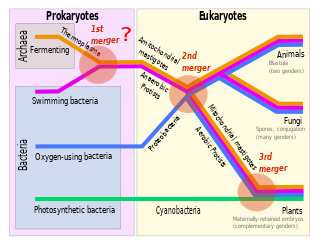
Symbiogenesis is the leading evolutionary theory of the origin of eukaryotic cells from prokaryotic organisms. The theory holds that mitochondria, plastids such as chloroplasts, and possibly other organelles of eukaryotic cells are descended from formerly free-living prokaryotes taken one inside the other in endosymbiosis. Mitochondria appear to be phylogenetically related to Rickettsiales bacteria, while chloroplasts are thought to be related to cyanobacteria.

The plastid is a membrane-bound organelle found in the cells of plants, algae, and some other eukaryotic organisms. They are considered to be intracellular endosymbiotic cyanobacteria. Examples include chloroplasts, chromoplasts, and leucoplasts.

The glaucophytes, also known as glaucocystophytes or glaucocystids, are a small group of unicellular algae found in freshwater and moist terrestrial environments, less common today than they were during the Proterozoic. The stated number of species in the group varies from about 14 to 26. Together with the red algae (Rhodophyta) and the green algae plus land plants, they form the Archaeplastida. However, the relationships among the red algae, green algae and glaucophytes are unclear, in large part due to limited study of the glaucophytes.
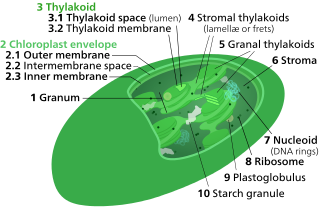
Thylakoids are membrane-bound compartments inside chloroplasts and cyanobacteria. They are the site of the light-dependent reactions of photosynthesis. Thylakoids consist of a thylakoid membrane surrounding a thylakoid lumen. Chloroplast thylakoids frequently form stacks of disks referred to as grana. Grana are connected by intergranal/stromal thylakoids, which join granum stacks together as a single functional compartment.
Heteroplasmy is the presence of more than one type of organellar genome within a cell or individual. It is an important factor in considering the severity of mitochondrial diseases. Because most eukaryotic cells contain many hundreds of mitochondria with hundreds of copies of mitochondrial DNA, it is common for mutations to affect only some mitochondria, leaving most unaffected.

Gracilaria is a genus of red algae (Rhodophyta) notable for its economic importance as an agarophyte, as well as its use as a food for humans and various species of shellfish. Various species within the genus are cultivated among Asia, South America, Africa and Oceania.

The Archaeplastida are a major group of eukaryotes, comprising the photoautotrophic red algae (Rhodophyta), green algae, land plants, and the minor group glaucophytes. It also includes the non-photosynthetic lineage Rhodelphidia, a predatorial (eukaryotrophic) flagellate that is sister to the Rhodophyta, and probably the microscopic picozoans. The Archaeplastida have chloroplasts that are surrounded by two membranes, suggesting that they were acquired directly through a single endosymbiosis event by feeding on a cyanobacterium. All other groups which have chloroplasts, besides the amoeboid genus Paulinella, have chloroplasts surrounded by three or four membranes, suggesting they were acquired secondarily from red or green algae. Unlike red and green algae, glaucophytes have never been involved in secondary endosymbiosis events.

The prasinophytes are a group of unicellular green algae. Prasinophytes mainly include marine planktonic species, as well as some freshwater representatives. The prasinophytes are morphologically diverse, including flagellates with one to eight flagella and non-motile (coccoid) unicells. The cells of many species are covered with organic body scales; others are naked. Well studied genera include Ostreococcus, considered to be the smallest free-living eukaryote, and Micromonas, both of which are found in marine waters worldwide. Prasinophytes have simple cellular structures, containing a single chloroplast and a single mitochondrion. The genomes are relatively small compared to other eukaryotes . At least one species, the Antarctic form Pyramimonas gelidicola, is capable of phagocytosis and is therefore a mixotrophic algae.

Red algae, or Rhodophyta, are one of the oldest groups of eukaryotic algae. The Rhodophyta also comprises one of the largest phyla of algae, containing over 7,000 currently recognized species with taxonomic revisions ongoing. The majority of species (6,793) are found in the Florideophyceae (class), and mostly consist of multicellular, marine algae, including many notable seaweeds. Red algae are abundant in marine habitats but relatively rare in freshwaters. Approximately 5% of red algae species occur in freshwater environments, with greater concentrations found in warmer areas. Except for two coastal cave dwelling species in the asexual class Cyanidiophyceae, there are no terrestrial species, which may be due to an evolutionary bottleneck in which the last common ancestor lost about 25% of its core genes and much of its evolutionary plasticity.

Eukaryota, whose members are known as eukaryotes, is a diverse domain of organisms whose cells have a nucleus. All animals, plants, fungi, and many unicellular organisms, are eukaryotes. They belong to the group of organisms Eukaryota or Eukarya, which is one of the three domains of life. Bacteria and Archaea make up the other two domains.
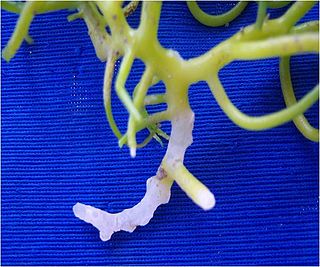
Ice-ice is a disease condition of seaweed. Ice-ice is caused when changes in salinity, ocean temperature and light intensity cause stress to seaweeds, making them produce a "moist organic substance" that attracts bacteria in the water and induces the characteristic "whitening" and hardening of the seaweed's tissues. Bacteria involved include those in the Vibrio-Aeromonas and Cytophaga-Flavobacteria complexes. The bacteria lyse epidermal cells and chloroplasts, turning the seaweed tissue white. The disease is known from seaweeds including Kappaphycus alvarezii and Eucheuma denticulatum, economically important sources of carrageenan. In countries where seaweed is harvested as a crop, ice-ice can wreak havoc on yields. Zamboanga, Philippines, had an outbreak of ice-ice in 2004, and Bali, Indonesia, experienced an outbreak in 2009. A rise in surface sea temperatures of 2–3 degrees Celsius can trigger ice-ice outbreaks.
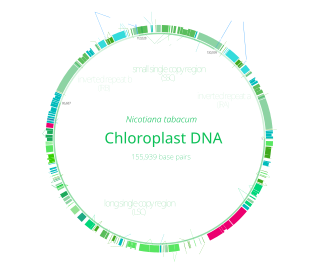
Chloroplast DNA (cpDNA) is the DNA located in chloroplasts, which are photosynthetic organelles located within the cells of some eukaryotic organisms. Chloroplasts, like other types of plastid, contain a genome separate from that in the cell nucleus. The existence of chloroplast DNA was identified biochemically in 1959, and confirmed by electron microscopy in 1962. The discoveries that the chloroplast contains ribosomes and performs protein synthesis revealed that the chloroplast is genetically semi-autonomous. The first complete chloroplast genome sequences were published in 1986, Nicotiana tabacum (tobacco) by Sugiura and colleagues and Marchantia polymorpha (liverwort) by Ozeki et al. Since then, a great number of chloroplast DNAs from various species have been sequenced.

Cyanidioschyzon merolae is a small (2μm), club-shaped, unicellular haploid red alga adapted to high sulfur acidic hot spring environments. The cellular architecture of C. merolae is extremely simple, containing only a single chloroplast and a single mitochondrion and lacking a vacuole and cell wall. In addition, the cellular and organelle divisions can be synchronized. For these reasons, C. merolae is considered an excellent model system for study of cellular and organelle division processes, as well as biochemistry and structural biology. The organism's genome was the first full algal genome to be sequenced in 2004; its plastid was sequenced in 2000 and 2003, and its mitochondrion in 1998. The organism has been considered the simplest of eukaryotic cells for its minimalist cellular organization.

Picozoa, Picobiliphyta, Picobiliphytes, or Biliphytes are protists of a phylum of marine unicellular heterotrophic eukaryotes with a size of less than about 3 micrometers. They were formerly treated as eukaryotic algae and the smallest member of photosynthetic picoplankton before it was discovered they do not perform photosynthesis. The first species identified therein is Picomonas judraskeda. They probably belong in the Archaeplastida as sister of the Rhodophyta.
Galdieria sulphuraria is an extremophilic unicellular species of red algae. It is the type species of the genus Galdieria. It is known for its broad metabolic capacities, including photosynthesis and heterotrophic growth on over 50 different extracellular carbon sources. The members of the class Cyanidiophyceae are among the most acidophilic known photosynthetic organisms, and the growth conditions of G. sulphuraria – pH between 0 and 4, and temperatures up to 56 °C – are among the most extreme known for eukaryotes. Analysis of its genome suggests that its thermoacidophilic adaptations derive from horizontal gene transfer from archaea and bacteria, another rarity among eukaryotes.
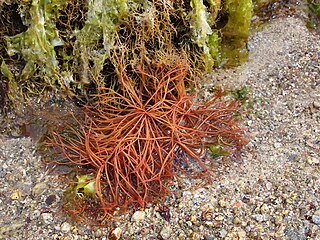
The Gracilariaceae is a small family of red algae containing several genera of agarophytes. It has a world-wide distribution. 24 species are found in China, and 6 species are found in Great Britain and Ireland. It is found in Australia and Chile.
The Pterocladiophilaceae is a small family of red algae containing 2 genera of thallus parasitic algae.

Peyssonneliales is a monotypic order of red algae belonging to the class Florideophyceae and the subclass Rhodymeniophycidae. It contains only 1 known family, PeyssonneliaceaeDenizot, M., 1968.















